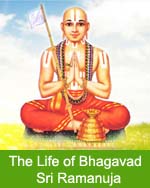 The Life of Bhagavad Sri Ramanuja (CE. 1017 to CE. 1137)
The Life of Bhagavad Sri Ramanuja (CE. 1017 to CE. 1137)
The Vedic Tradition
Ramanuja is regarded as the greatest theologian of the Vedic Lineage. The first of the great acharyas of the Vishistadvaita philosoply , Nathamuni, was from a traditional family of Sanskrit scholarship. His father was Iswarbhatt and his son was Iswaramuni. They lived in Viranarayanapuram. Nathamuni, is said to have taken the first steps towards a collation of Vaishnava philosophy and theology. The names of his two Sanskrit works are remembered and quoted, but neither has survived. Nathamuni also compiled the hymns of the Alvars, into a collection of four thousand verses (Nalayira Divya Prabandham). He also made arrangement for these “poems” to be chanted along with the Vedas during the services at Srirangam temple. He is also renowned as the founding father of Yoga. Yoga is the achievement of liberation from the cycle of bodily existences through a difficult process of mental and physical disciplines. The organization of the Vaishnava community was achieved by Nathamuni’s grandson Yamunacharya who was an accomplished Vedic scholar as well as a Vaishnava savant. Adopted into a royal family he lived a luxurious life in early days, but converted later and took to an ascetic life. He succeeded in consolidating the Vaishnava community and establishing Srirangam temple as their headquarters. It was his great ambition to merge the devotion of the Alvars with the Vedantic methodology. He could not himself achieve this ambition but towards the end of his life he met Ramanuja and recognized in him the competent Vedic scholar who could do it. The mission was entrusted to Ramanuja through his five principle disciples. Today there are over 700 Srivaishnava monasteries in all parts of India.
Works of Ramanuja – The Opus Magnus of Ramanuja is the Sri-bhashya — a commentary on the Vedanta-sutras of Badarayana which is one of the three basic texts of Vedanta (the others being the Bhagavad Gita and the Upanishads). Besides this, he produced nine other works. These are:—
- Vedanta-sangraha, an independent work expounding the philosophy of the Upanisads;
- Vedanta-sara
- Vedanta-dipa which are brief synopsises on the Vedanta-sutras;
- Gita-bhashya, a commentary on the Bhagavad Gita;
- Nitya-grantha dealing with daily rituals and devotional practices for Vaishnavas.
- Gadyatraya, three prose works which are of great sectarian importance with a theological base.
- Saranagati-gadya, an exposition on the greatness of self-surrender (prapatti) and the method thereof.
- Sriranga-gadya, is a prayer to Lord Sri Ranganatha to grant eternal servitude
- Vaikuntha Gadya which is a poetic description of Vaikuntha — the Lord’s eternal Transcendental Abode. This work is used as a contemplative device which brings great solace.
Index of the document:
- Birth of Ramanuja
- Early Life
- Discipleship under Yadava Prakasa
- Growing tension with Yadava Prakasa
- Yadava Praka’s attempt to murder Ramanuja
- Yamunacharya
- The dis-affection with Yadava Prakasa
- Under the guidance of Kanchipurna
- Yamunacharya’s demise
- Initiation
- Renunciation
- The coming of the Disciples
- Relocation to Srirangam
- Goshtipurna
- Ramanuja and the street boys
- The High Priest
- Yajnesa and Varada
- The Antics of Govinda
- The meeting with Yajna-murti
- The writing of the Sri Bhashya
- The Conquest
- Parasara Bhattar
- Dhanurdasa
- Kulottunga Chola 1
- King Bhittideva
- Sampat Kumara
- Return to Srirangam
- The last days
- The Final Teaching
- Pari Nirvana

